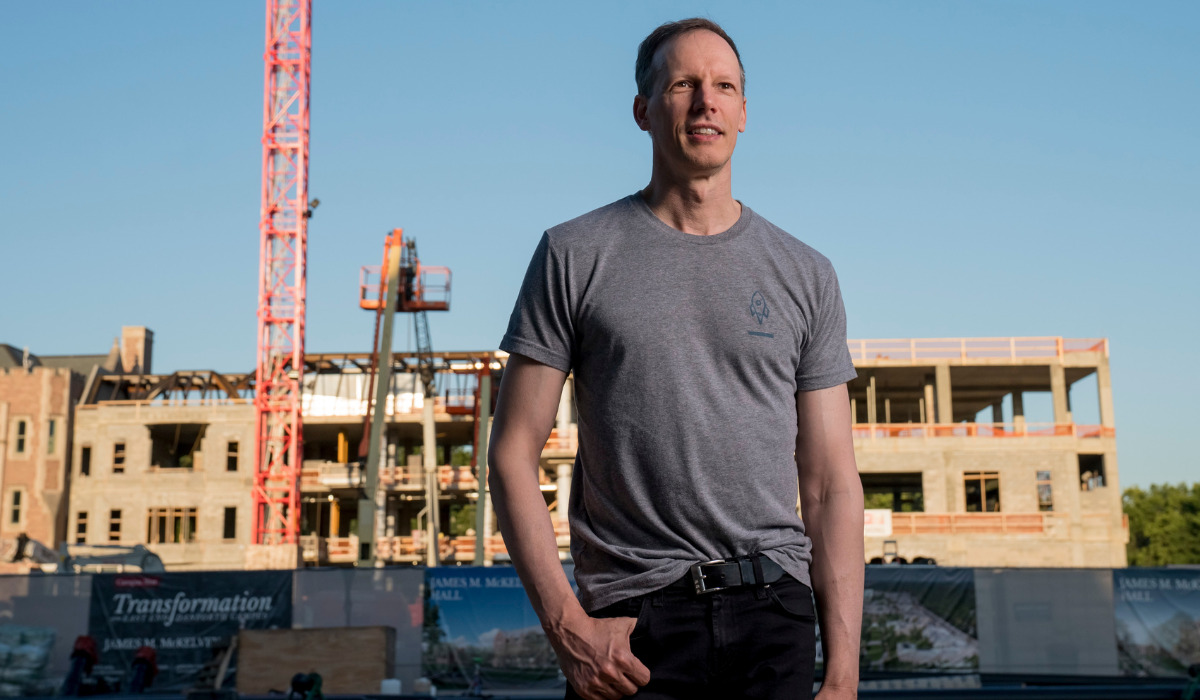Foundr Magazine publishes in-depth interviews with the world’s greatest entrepreneurs. Our articles highlight key takeaways from each month’s cover feature. We talked with Jim McKelvey, co-founder of Square, about building an unbeatable business. To read more, subscribe to the magazine.
—————
Jim McKelvey was packing his bags to move from St. Louis to Silicon Valley when a last-minute request came in from a client.
At the time, McKelvey was a professional glassblower. He had one piece he’d yet to sell: a monstrosity that he never liked but held at a $2,000 price tag.
Finally, someone was interested in it.
He rushed to his studio to make the transaction, but the client had an American Express card, and he couldn’t accept the payment. He lost the sale and kept the hideous art.
McKelvey was furious. He called his business partner, Jack Dorsey, with whom he was teaming up for his move to California.
“I said, ‘Hey, you know that idea we had? Well, forget it. I want to be able to get paid as an artist,’” McKelvey says.
What took three weeks to build became a three-year journey of creating Square (now Block, Inc.), a payment processing platform inspired by McKelvey’s frustrations. In the 15 years since McKelvey’s phone call with Dorsey, Square has grown into a billion-dollar business and beat the world’s best company at absorbing startups—Amazon.
As McKelvey sees it, his victory jump-started a journey to discover what it takes to build an unbeatable business.
Intern Turned Partner
McKelvey calls himself an outsider. He’s never been a popular guy, and that’s been an advantage in helping him tackle innovative ideas.
“If you want to do something weird, I’m your guy,” he says.
After studying economics and computer science in college, McKelvey launched his first business, which published CD-ROMs for trade shows. In the pre-internet world, McKelvey’s business collected information from paper pamphlets for every company involved in the trade show then stored them on a CD.
Businesses attending trade shows paid to have their information included. The trade shows purchased the CDs to create a better experience for attendees.
The business was thriving, but McKelvey saw the writing on the wall. He knew his entire business model would collapse as soon as his customers discovered how to build a website on the fast-growing internet. So, he gathered his team and charged them with brainstorming how to shift the business model. Two weeks later, the team came back with nothing.
“They were so addicted to what they were already doing that none of them changed,” McKelvey says.
But there was one employee who understood the assignment: a high school summer intern named Jack Dorsey. The two hit it off, and that summer, they transformed the business model into scientific publishing that eventually saved the company.
Dorsey would go on to attend college and eventually co-found Twitter. (You can read Dorsey’s interview with foundr in Issue 86.) McKelvey stayed in St. Louis and started his glassblowing business. They kept in touch until Dorsey was unceremoniously forced out of Twitter in 2008.
“I was pretty pissed at what they were doing to my friend,” McKelvey says. “Jack said, ‘Why don’t we do something positive with that energy?’”
Together, they committed to building something new—as long as it wasn’t a social media platform. All they knew was that their new concept needed to be mobile-friendly in the wake of the iPhone’s launch in 2007.
When McKelvey called Dorsey about wanting to solve his payment processing issue, the two jumped into creating a solution that they expected to be relatively simple.
Within three weeks, they had built a credit card reader that plugs into the headphone jack of an iPhone and an app that processed credit card payments to the user’s bank account.
Problem solved. Or not.
“That would have been great—if it would have gone the way we expected it to go,” McKelvey says. “The problem is that it broke 17 laws.”
Keep Learning: Get the mindset that helped McKelvey beat Amazon in his foundr course How to Build an Unbeatable Business.
Facing Financial Giants
McKelvey and Dorsey weren’t building a solution for mobile transactions. Instead, they were battling an archaic system that wasn’t friendly to startups.
“The banking system was never designed to admit small players. It was designed for big companies,” McKelvey says.
“From the hardware to the contracts to the banking relations to the finance, everything had to be reinvented, which drove us up a wall. But ultimately, it turned into this thing that performed a miracle.”
Mastercard was one of the financial giants they needed to face for Square to work. For 20 years, the credit card company maintained a rule specifically prohibiting card-present payment processors, which was the foundation of what Square was doing.
A year and a half into the business, McKelvey and Dorsey booked a meeting with Mastercard executives. They were confident in their polished pitch.
“I’m normally a talker, but when I’m demoing, I never interrupt. I never say anything,” McKelvey says. “Jack sits like a monk and doesn’t get nervous.”
The two walked into the meeting room and gave their pitch. Right away, McKelvey asked the head of Mastercard for his credit card to demo the swiping attachment.
“I said, ‘Great, a dollar just went into my bank account.’ And he’s like, ‘That’s a demo, right?’”
McKelvey answered, “No, it’s live.”
“He said, ‘Do you realize what you just did violated our regulating operations?’ And I said, ‘Yes sir, I know that.’”
The boardroom went silent. Twenty long and awkward seconds later, the head of Mastercard looked at his team and then back to McKelvey and Dorsey.
Finally, he spoke: “Well, I guess we’ll have to change our regulations.”
He stood up and walked out of the room.
“I think if I said anything after that, it might have killed it,” McKelvey says, remembering the fateful meeting. “If we had been anything else but focused outward, it might have gone sideways.”
McKelvey says the executive got it. They clearly presented a problem and solution without directly asking the company to change the regulation. Mastercard had no choice but to adapt.
By proving how Square works in real time and “shutting up,” they persuaded one of their toughest competitors to join them. That meeting, McKelvey says, ended up legitimizing Square and transforming their business.
But McKelvey didn’t know that a more terrifying giant was looming in the distance.
Beating the Fearsome Predator
A year and a half later, Amazon came after Square.
“Amazon is the most fearsome predator on the planet,” McKelvey says.
“At the time they attacked us, they had a 100 percent success rate, which is to say every time Amazon attacked a startup or young company and wanted their market, they took it.”
Amazon’s acquisition strategy, according to McKelvey, involves three steps. First, they copy your product. Next, they cut the price by 30 percent. And last, they slap the Amazon smile on the product.
“We were terrified,” McKelvey says. He frantically searched to see if any startup had survived the onslaught of Amazon, and all he found were “corpses” of acquired businesses.
“We really didn’t know what to do, so we didn’t change anything,” McKelvey says.
A year later, Amazon quit trying to compete with Square and mailed a Square credit card reader to every one of their soon-to-be former customers.
“So they basically said, ‘We can’t do credit card processing for you. You’re better off with Square. Here’s a Square reader for free. Go with Square,’” McKelvey says.
Not surprisingly, Square gained customers in the process. McKelvey says Square’s ability to overcome 14 different financial roadblocks made the business battle-tested and challenging to compete with—even for Amazon.
“For [another company] to get 14 things right all at once [was] almost impossible,” McKelvey says.
But for McKelvey, the question was, “Why?” He didn’t believe they were that lucky, and it motivated him to understand what it takes for a business to venture into the unknown—and win.
“It was relief, and then frustration, and then confusion,” McKelvey says. “If you put yourself in a situation where the only option is creating something new, you can do that. It’s just really, really difficult. And it’s not something that we understand as humans.”






















